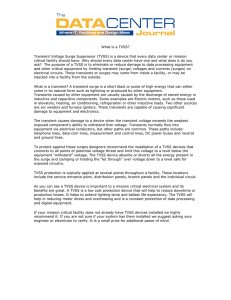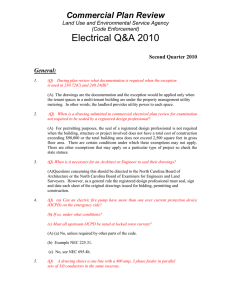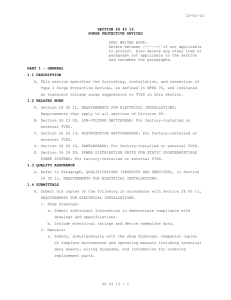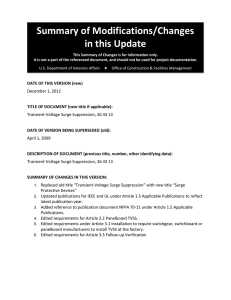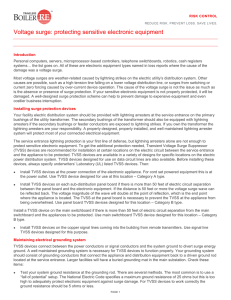Installing TVSS Units with the Required Overcurrent Protection Device
advertisement
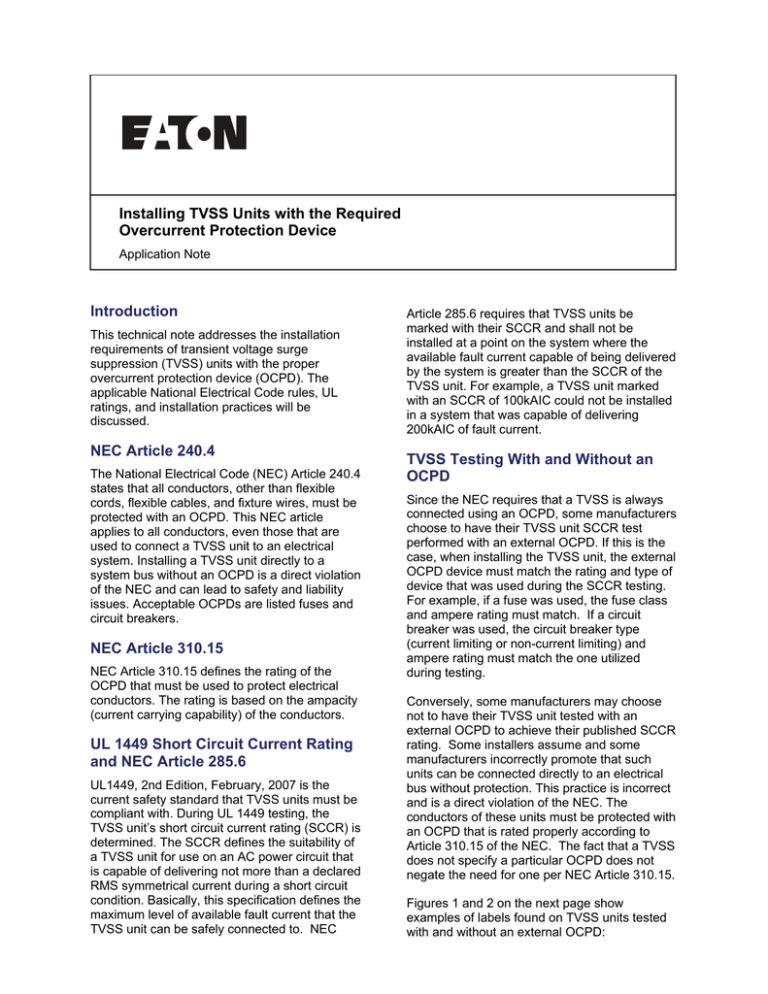
Installing TVSS Units with the Required Overcurrent Protection Device Application Note Introduction This technical note addresses the installation requirements of transient voltage surge suppression (TVSS) units with the proper overcurrent protection device (OCPD). The applicable National Electrical Code rules, UL ratings, and installation practices will be discussed. NEC Article 240.4 The National Electrical Code (NEC) Article 240.4 states that all conductors, other than flexible cords, flexible cables, and fixture wires, must be protected with an OCPD. This NEC article applies to all conductors, even those that are used to connect a TVSS unit to an electrical system. Installing a TVSS unit directly to a system bus without an OCPD is a direct violation of the NEC and can lead to safety and liability issues. Acceptable OCPDs are listed fuses and circuit breakers. NEC Article 310.15 NEC Article 310.15 defines the rating of the OCPD that must be used to protect electrical conductors. The rating is based on the ampacity (current carrying capability) of the conductors. UL 1449 Short Circuit Current Rating and NEC Article 285.6 UL1449, 2nd Edition, February, 2007 is the current safety standard that TVSS units must be compliant with. During UL 1449 testing, the TVSS unit’s short circuit current rating (SCCR) is determined. The SCCR defines the suitability of a TVSS unit for use on an AC power circuit that is capable of delivering not more than a declared RMS symmetrical current during a short circuit condition. Basically, this specification defines the maximum level of available fault current that the TVSS unit can be safely connected to. NEC Article 285.6 requires that TVSS units be marked with their SCCR and shall not be installed at a point on the system where the available fault current capable of being delivered by the system is greater than the SCCR of the TVSS unit. For example, a TVSS unit marked with an SCCR of 100kAIC could not be installed in a system that was capable of delivering 200kAIC of fault current. TVSS Testing With and Without an OCPD Since the NEC requires that a TVSS is always connected using an OCPD, some manufacturers choose to have their TVSS unit SCCR test performed with an external OCPD. If this is the case, when installing the TVSS unit, the external OCPD device must match the rating and type of device that was used during the SCCR testing. For example, if a fuse was used, the fuse class and ampere rating must match. If a circuit breaker was used, the circuit breaker type (current limiting or non-current limiting) and ampere rating must match the one utilized during testing. Conversely, some manufacturers may choose not to have their TVSS unit tested with an external OCPD to achieve their published SCCR rating. Some installers assume and some manufacturers incorrectly promote that such units can be connected directly to an electrical bus without protection. This practice is incorrect and is a direct violation of the NEC. The conductors of these units must be protected with an OCPD that is rated properly according to Article 310.15 of the NEC. The fact that a TVSS does not specify a particular OCPD does not negate the need for one per NEC Article 310.15. Figures 1 and 2 on the next page show examples of labels found on TVSS units tested with and without an external OCPD: Figure 1 – TVSS unit that was tested with an external OCPD. Note that the unit’s SCCR is listed, along with the type and rating of the required OCPD: internal OCPD, NEC Article 240.21(B)(1) may be applied to certain installations. This article is called the Feeder Tap Rule. In order to apply the Feeder Tap Rule to the installation of a TVSS unit with an internal OCPD, all of the following conditions must be met: 1) The length of the tap conductors must be not be over 10 feet – e.g. the TVSS unit’s connecting conductors cannot be more than 10 feet in length. Rules also exist for taps greater than 10 feet, but discussing them would be impractical in a TVSS installation application. When installing a TVSS unit, the conductors should always be kept as short as possible, far less than 10 feet in length. Figure 2 – TVSS unit that was tested without an external OCPD. Note that the unit’s SCCR is listed but an OCPD is not defined. The proper one must be used per the NEC: 2) The ampacity of the tap conductors must not be less than the rating of the OCPD at the termination of the tap conductors – e.g. the ampacity of the TVSS unit’s connecting conductors cannot be less than the rating of its internal OCPD – 12AWG conductors (25A ampacity) could not be used to connect a TVSS unit containing an internal 30A OCPD. At minimum, 10AWG conductors (30A ampacity) would have to be used. 3) The rating of the OCPD on the line side of the tap conductors must not exceed 10 times the ampacity of the tap conductors – e.g. the upstream OCPD in the panel or source that the TVSS unit was tapped from cannot be rated at more than 10 times the ampacity of the TVSS unit’s wires – if the TVSS unit utilizes 10AWG wires (30A ampacity), the maximum allowable value of the upstream OCPD would be 300A. Summary TVSS Units Containing an Internal OCPD and the Feeder Tap Rule Some TVSS units contain an internally mounted OCPD such as a fuse or circuit breaker. A common myth exists that because of the internal OCPD, the unit can be connected directly to the electrical bus without protection. These units are also governed by the requirements defined in NEC Article 240.4. Failure to utilize an upstream OCPD to protect the unit’s conductors is a direct violation of the NEC and could lead to liability and safety issues. There are certain conditions or exceptions to this rule that can allow OCPDs with a higher rating than outlined in NEC Article 240.4 to be utilized. In order to take advantage of a TVSS unit’s Eaton Corporation 1000 Cherrington Parkway Moon Township, PA 15108-4312 When installing TVSS units, both NEC and UL requirements must be followed. The proper OCPD must be used in order to meet NEC requirements and maintain the unit’s UL listing. If the unit was submitted for UL testing with an external OCPD, the size and type required for installation will be listed on a label found on the unit. If an external OCPD was not used during UL testing, the size and type will not be listed on the unit’s label. Under this condition, it is the responsibility of the installer to ensure that the conductors of the TVSS unit are protected per the NEC. TVSS units containing an internal OCPD can be connected directly to the electrical bus only if the installation meets all of the requirements defined in NEC Article 240.21(B)(1), the Feeder Tap Rule. Phone: 1-800-525-2000 Web: www.Eaton.com Publication No. TD01005003E Effective Date: March 2008
